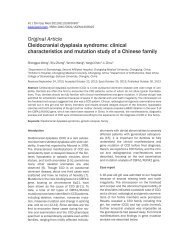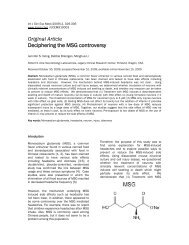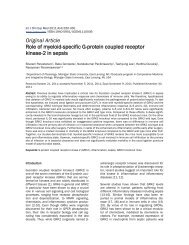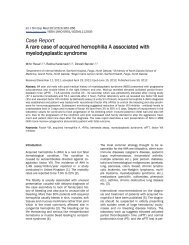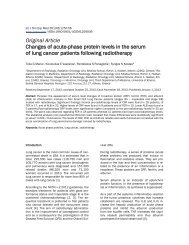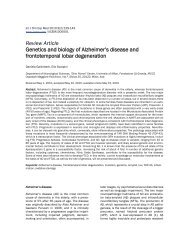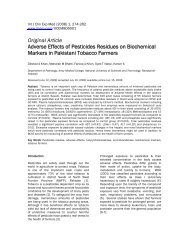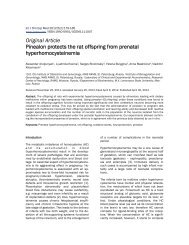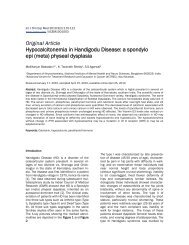Multiple different laminar velocity profiles in separate veins in the ...
Multiple different laminar velocity profiles in separate veins in the ...
Multiple different laminar velocity profiles in separate veins in the ...
You also want an ePaper? Increase the reach of your titles
YUMPU automatically turns print PDFs into web optimized ePapers that Google loves.
Lam<strong>in</strong>ar <strong>velocity</strong> <strong>in</strong> microvascular network of bra<strong>in</strong><br />
blood cell <strong>velocity</strong>, which if it is <strong>different</strong>, counteracts<br />
mix<strong>in</strong>g of blood corpuscles [17]; thirdly,<br />
<strong>the</strong> high vessel density <strong>in</strong> this tissue may contribute<br />
fur<strong>the</strong>r to <strong>the</strong> phenomenon.<br />
One physiologically important consequence of<br />
<strong>the</strong> described phenomenon is that it, although<br />
we did not specifically exam<strong>in</strong>e this <strong>in</strong> <strong>the</strong> present<br />
paper, may affect <strong>the</strong> process of extravasation<br />
of <strong>the</strong> WBC and <strong>the</strong> exchange of molecules<br />
<strong>in</strong>clud<strong>in</strong>g oxygen and carbon dioxide between<br />
erythrocytes and <strong>the</strong> tissues, and <strong>the</strong>reby also<br />
have consequences for <strong>the</strong> <strong>in</strong>flammatory process.<br />
This is currently of particular importance as<br />
<strong>the</strong>re has been an evolv<strong>in</strong>g new description of<br />
<strong>the</strong> blood cell-endo<strong>the</strong>lial cell <strong>in</strong>teractions <strong>in</strong> <strong>the</strong><br />
cerebral circulation [4]. There is evidence that<br />
suggests that <strong>the</strong>re are qualitative and quantitative<br />
differences <strong>in</strong> <strong>the</strong> microvascular response<br />
to <strong>in</strong>flammation <strong>in</strong> <strong>the</strong> bra<strong>in</strong> compared with<br />
o<strong>the</strong>r organs such as liver, skeletal muscle and<br />
mesentery [4]. The cerebrovascular endo<strong>the</strong>lial<br />
cells have a number of unique characteristics,<br />
<strong>in</strong>clud<strong>in</strong>g <strong>the</strong>ir barrier, transport, metabolic, and<br />
cell traffik<strong>in</strong>g properties. These differences may<br />
also depend on a <strong>different</strong> underly<strong>in</strong>g rheology.<br />
The multi <strong>lam<strong>in</strong>ar</strong> blood flow <strong>profiles</strong> that have<br />
been described would <strong>the</strong>oretically lead to a<br />
decreased extravasation of WBC´s as <strong>the</strong>y<br />
would make traffick<strong>in</strong>g even more difficult. Such<br />
effects may for example, emphasize <strong>the</strong> f<strong>in</strong>d<strong>in</strong>g<br />
of few WBC <strong>in</strong> <strong>the</strong> bra<strong>in</strong> parenchyma, which has<br />
led to <strong>the</strong> claim that <strong>the</strong> bra<strong>in</strong> is an immunologically<br />
privileged organ [4]. The rheological state<br />
described, multi <strong>lam<strong>in</strong>ar</strong> flow <strong>profiles</strong>, may fur<strong>the</strong>r<br />
contribute to difficulties for <strong>the</strong> WBC to extra-vasate.<br />
For example <strong>the</strong> WBC extravasation<br />
<strong>in</strong> <strong>the</strong> bra<strong>in</strong> is claimed to be less than 1:20 of<br />
that seen <strong>in</strong> <strong>the</strong> skeletal muscle [18]. This f<strong>in</strong>d<strong>in</strong>g<br />
has previously been described and claimed<br />
to be <strong>the</strong> result of several factors such as: low<br />
basal expression of endo<strong>the</strong>lial cell adhesion<br />
molecules [18]; a high electrostatic charge on<br />
<strong>the</strong> cerebrovascular endo<strong>the</strong>lial cells [19]; and<br />
high venular shear rates that tend to oppose<br />
adhesion of blood cells [8]. Added to <strong>the</strong>se factors<br />
may also be <strong>the</strong> multi <strong>lam<strong>in</strong>ar</strong> blood flow<br />
profile effect described here and this needs to<br />
be fur<strong>the</strong>r exam<strong>in</strong>ed and confirmed <strong>in</strong> future<br />
studies.<br />
An important contribut<strong>in</strong>g factor that has led to<br />
<strong>the</strong> presented f<strong>in</strong>d<strong>in</strong>gs is <strong>the</strong> use of a new imag<strong>in</strong>g<br />
technique (OPS). We th<strong>in</strong>k that <strong>the</strong> specifics<br />
of this technique provide <strong>the</strong> technical background<br />
to picture local variations <strong>in</strong> hematocrit<br />
more easily. OPS is based on that <strong>the</strong> polarized<br />
light is absorbed by <strong>the</strong> red blood corpuscles<br />
and <strong>the</strong> red blood cells are seen as dark images.<br />
The correspond<strong>in</strong>g layers of plasma skimm<strong>in</strong>g<br />
do not absorb <strong>the</strong> light and are depicted <strong>in</strong><br />
<strong>the</strong> video images as white streaks that enable<br />
<strong>the</strong> observer to dist<strong>in</strong>guish <strong>the</strong>m from <strong>the</strong> mass<br />
of red cells [20]. That comb<strong>in</strong>ed with <strong>the</strong> th<strong>in</strong><br />
layer of <strong>the</strong> venular wall, facilitates <strong>the</strong> observation<br />
of vary<strong>in</strong>g local vessel hematocrit. The<br />
lower blood cell <strong>velocity</strong> <strong>in</strong> <strong>the</strong> ve<strong>in</strong>s fur<strong>the</strong>r amplifies<br />
<strong>the</strong> discrim<strong>in</strong>ative power of <strong>the</strong> <strong>in</strong>vestigator.<br />
Apart from <strong>the</strong> fact that <strong>the</strong>y are less prevalent,<br />
it was more difficult technically to f<strong>in</strong>d correspond<strong>in</strong>g<br />
phenomena <strong>in</strong> <strong>the</strong> arterial tree. This<br />
may be partly due to <strong>the</strong> difficulty of OPS light<br />
penetration through <strong>the</strong> arterial wall, and <strong>the</strong><br />
higher blood cell <strong>velocity</strong> <strong>in</strong> <strong>the</strong>se vessels. Arterial<br />
to arterial branch<strong>in</strong>g was also less redundant.<br />
The underly<strong>in</strong>g mechanisms for <strong>the</strong>se rheological<br />
f<strong>in</strong>d<strong>in</strong>gs is that <strong>the</strong> resistance to flow is less<br />
<strong>in</strong> <strong>the</strong> areas of <strong>the</strong> vessel border, which leads to<br />
a central concentration of <strong>the</strong> red blood cells,<br />
and simultaneously plasma is marg<strong>in</strong>alized at<br />
<strong>the</strong> endo<strong>the</strong>lial end. The underly<strong>in</strong>g rheological<br />
physiology also leads to a <strong>velocity</strong> <strong>in</strong>crease of<br />
<strong>the</strong> red cells at <strong>the</strong> central core of <strong>the</strong> vessel.<br />
As <strong>the</strong> blood cells are affected by <strong>the</strong> <strong>in</strong>creas<strong>in</strong>g<br />
speed at <strong>the</strong> center, forces are liberated that<br />
tend to rotate <strong>the</strong> blood cell and fur<strong>the</strong>r facilitate<br />
<strong>the</strong> migration of <strong>the</strong> red blood corpuscle<br />
towards <strong>the</strong> center l<strong>in</strong>e [21, 22].<br />
Ano<strong>the</strong>r important factor that contributes to <strong>the</strong><br />
f<strong>in</strong>d<strong>in</strong>gs of <strong>the</strong> present study is <strong>the</strong> use of a validated<br />
animal model. This model is based on<br />
<strong>in</strong>halation anes<strong>the</strong>sia, and special care was<br />
taken not to alter <strong>the</strong> circulatory or ventilatory<br />
sett<strong>in</strong>gs once <strong>the</strong> preparation was stable [9].<br />
Us<strong>in</strong>g a from environmental high oxygen and<br />
low carbon dioxide closed microvascular preparation<br />
also reduces any effects of <strong>the</strong> atmospheric<br />
gases, particularly vasoconstriction <strong>in</strong>duced<br />
by a low carbon dioxide, which are known<br />
to affect <strong>the</strong> microvascular preparations and<br />
alter microvascular rheology [23].<br />
In summary we have shown that multi <strong>lam<strong>in</strong>ar</strong><br />
flow <strong>profiles</strong> are common phenomena <strong>in</strong> <strong>the</strong><br />
venous microvasculature of <strong>the</strong> rat bra<strong>in</strong>. The<br />
f<strong>in</strong>d<strong>in</strong>gs may be expla<strong>in</strong>ed by <strong>the</strong> high and heterogeneous<br />
metabolic rate and <strong>the</strong> complex<br />
15 Int J Cl<strong>in</strong> Exp Med 2011;4(1):10-16



